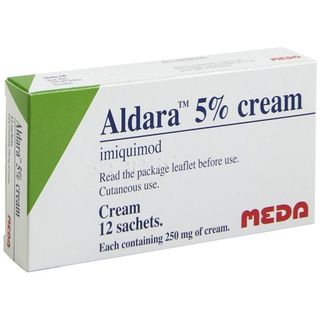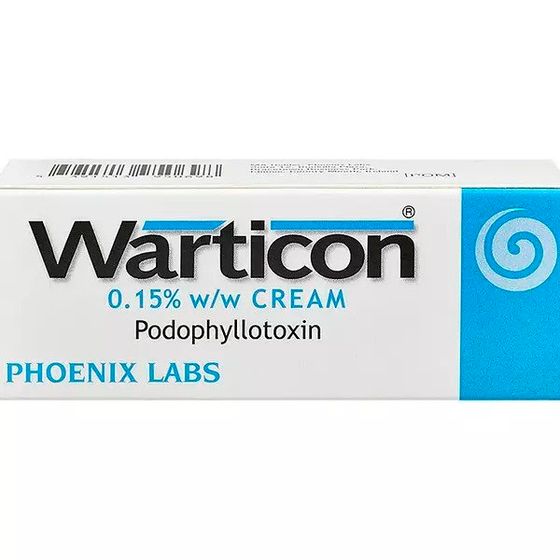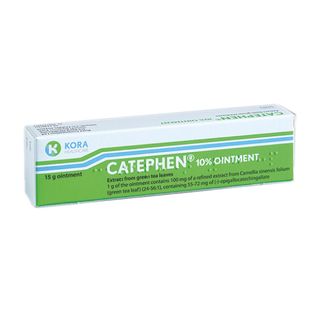

Warticon Cream & Solution For Treatment Of Genital Warts
- Effectively clears genital warts with noticeable results within 4-5 weeks
- Contains podophyllotoxin, which actively kills the HPV virus causing genital warts
- Simple treatment cycle of only 3 consecutive days per week
- Available in both cream and solution formats to suit your preference
- Discreet online consultation with quick delivery in plain packaging
- Fast, discreet delivery
- 100% UK-based pharmacy
- Free advice and support
- We're rated 4.9 out of 5
Based on over 30,000 reviews collected on Google and Reviews.io.
We maintain the highest possible regulation for a UK online pharmacy, ensuring your experience is safe, and confidential.
Buy Warticon Cream and Solution Online
Warticon is a prescription-only treatment for external genital warts. It contains podophyllotoxin, a plant-based antiviral that targets the underlying HPV virus rather than just the warts that HPV causes. By stopping the virus from multiplying, Warticon helps the wart cells die off so healthy skin can grow in their place.
When used correctly, Warticon can completely clear genital warts within four weeks. To use Warticon, you apply it twice a day for three consecutive days, followed by four days of no treatment. This can be repeated up to four times.
Warticon is available as both a white 0.15% cream and a blue 0.5% solution formulation. The solution comes with applicators for easier, more precise application.
Our clinical team will guide you through a quick and easy consultation to help you choose the best option based on your situation. If you’re ready to start treatment, you can begin the discreet consultation today.
- 2
- 3
Warticon Cream and Solution Summary
About Warticon Cream and Solution
Warticon is a prescription-only medicine containing podophyllotoxin, designed to treat external genital warts located on the penis, vagina, and surrounding genital area. It’s not suitable for treating anal warts. It's available in two different strengths: white 0.15% cream or blue 0.5% solution with applicators. Each pack contains enough treatment for a complete treatment course - four weeks’ worth.
How Does Warticon Work?
The active ingredient in Warticon is podophyllotoxin. Podophyllotoxin targets the virus that causes genital warts and allows them to continue to grow. It stops the HPV virus from dividing and spreading, rather than just treating the wart tissue directly. Doing this helps the wart cells die off, allowing the warts to fall away. Healthy skin cells then grow in their place. Warticon treats the root cause of genital warts, instead of just the surface symptoms, which makes it more effective than treatments that only work on the warts.
How To Take/Use Warticon Cream & Solution
To use Warticon, apply it twice a day, 12 hours apart, for three days in a row, then take a four day break. This is one full treatment cycle. Repeat for a maximum of four treatment cycles.
First, wash the affected area with soap and water, and dry with a clean towel. Use your fingertip to apply the treatment directly to the warts for the cream version. The solution option has special applicators that allow you to apply it easily. Always avoid healthy skin, applying only to your warts, and only ever use externally. If you accidentally get Warticon on healthy skin, rinse thoroughly with soap and water.
If you’re using the solution, be careful - it’s flammable. Keep away from flames or heat during and after use.
Ingredients
The active ingredient in Warticon is podophyllotoxin. This is at a strength of 0.15% in the cream and 0.5% in the solution. The cream includes inactive ingredients like the preservatives methyl and propyl parahydroxybenzoates (E218 and E216), as well as sorbic acid, phosphoric acid, stearyl and cetyl alcohols, and butyl hydroxyanisole (E320). The solution is alcohol-based and contains ethanol, phosphoric acid, Patent Blue V (E131 - a blue colouring), and purified water.
Side Effects
Like all medicines, Warticon can cause side effects, although not everybody gets them. You may experience none at all, or you may experience one or a combination of side effects. These include mild skin irritation, redness, burning sensation, itching, and erosion of the top layers of skin in the areas you’ve used the treatment. They typically happen after two to three days of use, and are usually signs that the treatment is working. They’ll only impact the treated area and shouldn't affect the rest of your body.
However, if you experience severe burning, stinging, pain, bleeding, swelling or intense irritation, you should clean the area with soap and water and seek medical attention immediately.
Warnings
You should not use Warticon on broken, damaged, or bleeding skin or large areas over 4cm² (roughly the size of a postage stamp). Warticon is only for external use and so you shouldn’t use it on any warts that are inside your vagina, under the foreskin of your penis or inside your rectum.
Other important considerations to be aware of include avoiding sexual contact while you’re using the treatment. Genital warts are highly contagious and can easily spread from one person to another. Not only that, but podophyllotoxin is an irritant and could cause discomfort to your sexual partner.
If you’re pregnant or breastfeeding, you shouldn’t use Warticon. Always keep the cream or solution away from your eyes and away from healthy skin. If you accidentally get either on healthy skin, rinse with soap and water. Never cover the treated areas with plasters.
The solution is flammable, so you should always keep away from flames or heat when using this formulation.
Warticon Cream & Solution For Treatment Of Genital Warts reviews
Warticon Cream & Solution For Treatment Of Genital Warts FAQs
What Is The Difference Between Warticon Cream And Solution?
Warticon Cream and Solution both treat external genital warts using the same active ingredient, podophyllotoxin, but there are a few key differences.
They vary in strength, with the cream containing 0.15% podophyllotoxin, compared to the solution’s 0.5%. The cream is white and thicker than the solution, which is blue and may temporarily colour the skin. Typically, the cream is recommended for women and the solution for men, but both are equally effective. Some people find the cream easier to control, while others prefer the applicators with the solution.
Although the solution is stronger, they both have similar success rates. Choosing between the two formulations can often come down to personal preference, as well as the location of the warts. Your prescriber will help you choose the most suitable option for your needs.
How Long Does Warticon Take To Work?
Warticon typically starts to work within the first few days of treatment. You should see noticeable improvement after one or two weekly treatment cycles. Each cycle lasts a week and involves using Warticon twice daily for three days, followed by four days without treatment.
Following this plan, your warts should be cleared entirely within four to five weeks. If you still have warts after the maximum four treatment cycles, you should speak to your doctor as you may have to consider alternative treatments like freezing the warts off with cryotherapy.
Is Warticon Painful To Use?
As Warticon starts to work, you may experience mild discomfort. It can cause irritation, such as a burning or stinging sensation, in the area where you use it. This is usually manageable and settles as your body gets used to the treatment.
However, severe pain is not normal, and if you experience it, you should stop treatment immediately and speak to our clinical team. To minimise the risk of discomfort, apply the treatment carefully only to warts. If you do get Warticon on healthy skin, make sure you rinse the area thoroughly with soap and water straight away.
Can I Use Warticon During Pregnancy?
If you’re pregnant or breastfeeding, you should not use Warticon. If you’re of childbearing age, it’s important to use reliable contraception for the duration of your treatment.
This is because it could harm the health of your baby. If you are pregnant, planning to become pregnant, or breastfeeding, speak to our clinical team for alternative treatment options that are most suitable during this time. This restriction applies to both the cream and solution formulations.
Can I Have Sex While Using Warticon?
It’s recommended that you avoid sexual contact while using Warticon. Genital warts are highly contagious and can be transmitted even when using condoms. Warticon can irritate the skin and if you have sexual contact during the active treatment days you risk the treatment causing your partner discomfort.
If you do have sexual contact, use non-latex condoms to reduce the chance of spreading HPV as well as to prevent transferring the medication to your partner’s skin. Ideally, it’s best to wait until the warts have cleared and your skin has healed before having sexual contact.
What Should I Do If Warticon Gets On Healthy Skin?
Warticon can cause irritation to normal skin, so you should only apply it directly to warts. If you accidentally get it in contact with healthy skin, you should immediately wash the area thoroughly with soap and water.
For the cream, use a fingertip to apply it to cover each wart and rub it in. Wash your hands thoroughly when you’re done.
If you’re using the solution, use a new applicator each time you apply Warticon. For small warts, dip the loop end of the applicator into the solution. For larger warts or lots of warts in a small area, use the spatula end of the applicator. Apply the solution to each wart until it is just covered and allow it to dry before letting other skin touch the affected area. Wash your hands thoroughly after use.
Can Warticon Be Used For All Types Of Warts?
Warticon is specifically licensed for external genital warts found on your penis, or vagina, and the surrounding genital area. It’s not suitable for anal warts, internal genital warts, or common warts on other parts of the body like the hands or feet. Different types of warts have different causes and so need different treatments. Warticon tackles warts caused by the HPV virus. Using Warticon incorrectly can lead to serious skin irritation or damage.
How Many Treatment Cycles Will I Need?
Everyone is different, and there’s no one-size-fits-all number of treatment cycles that you’ll need. The recommended treatment protocol is a maximum of four weekly cycles. Each weekly cycle consists of three days of twice-daily treatment followed by four days of rest. It’s likely that your symptoms will completely resolve within this timeframe, but rarely, warts may persist. If your warts are still there after completing the full recommended course, it’s worth speaking to a medical professional, as you may need alternative treatments.
Will My Genital Warts Come Back After Using Warticon?
While the ideal result is that your warts go away for good, there is a possibility that they will come back. Warticon treats the visible warts but doesn’t completely get rid of the underlying HPV from the body. This means the virus could cause more warts to form.
Different treatments may have varying recurrence rates compared to podophyllotoxin treatments like Warticon and Condyline. Aldara (imiquimod) is one that may have a lower chance of the warts returning, because it can help boost your immune response against the virus.
If your warts frequently come back, it’s important to seek follow-up care by speaking to our clinical team. You may need different treatments to reduce the chance of them returning so often.
What Are The Alternatives To Warticon?
There are topical and physical alternatives to Warticon. Other topical treatments include Condyline, which also contains podophyllotoxin, and Aldara, which contains imiquimod. Aldara works differently from the podophyllotoxin-based treatments. It stimulates the immune system, which means that it may have lower recurrence rates. However, it can be more expensive.
If you have larger or more widespread warts, physical options like cryotherapy (freezing), surgical removal, or laser therapy may be more effective.
How Do I Buy Warticon Cream & Solution Online?
To order Warticon Cream or Solution from The Independent Pharmacy, you’ll first need to complete a discreet, quick and easy online consultation. One of our UK-based prescribers will review your consultation to make sure Warticon is suitable for you. If approved, they’ll issue you a prescription and your treatment will be on its way to your door.
The service is entirely confidential, with plain packaging for delivery. You’ll also have support from the pharmacy team available throughout your treatment.
Related Treatments
 Aldara Cream For Genital Warts£69.99
Aldara Cream For Genital Warts£69.99
Catephen
Catephen 10% Ointment£59.99
Visit our Genital Warts page for treatments, advice and FAQs.
Ordering as easy as 1, 2, 3
1. Find the ideal treatment
2. Get a free consultation
3. Enjoy speedy delivery